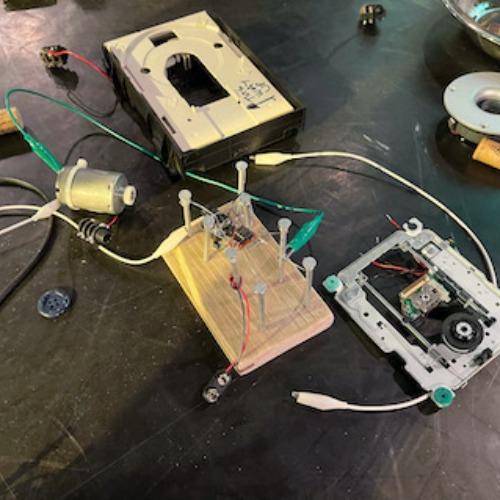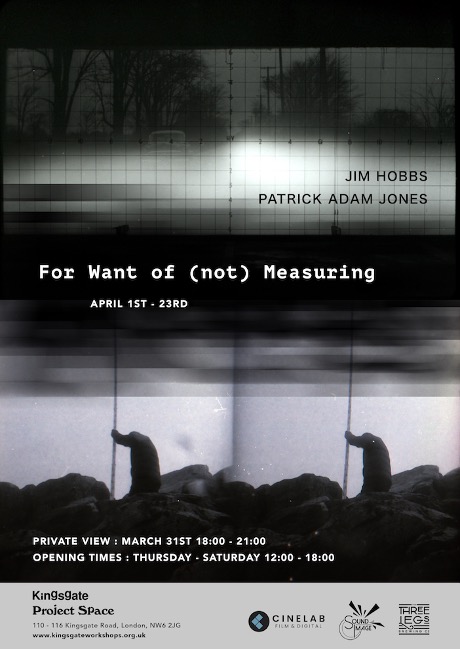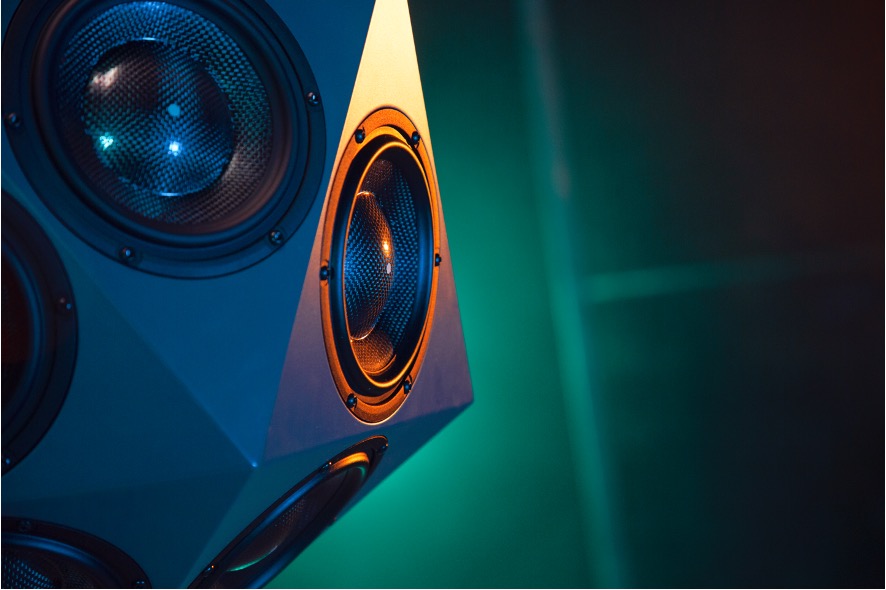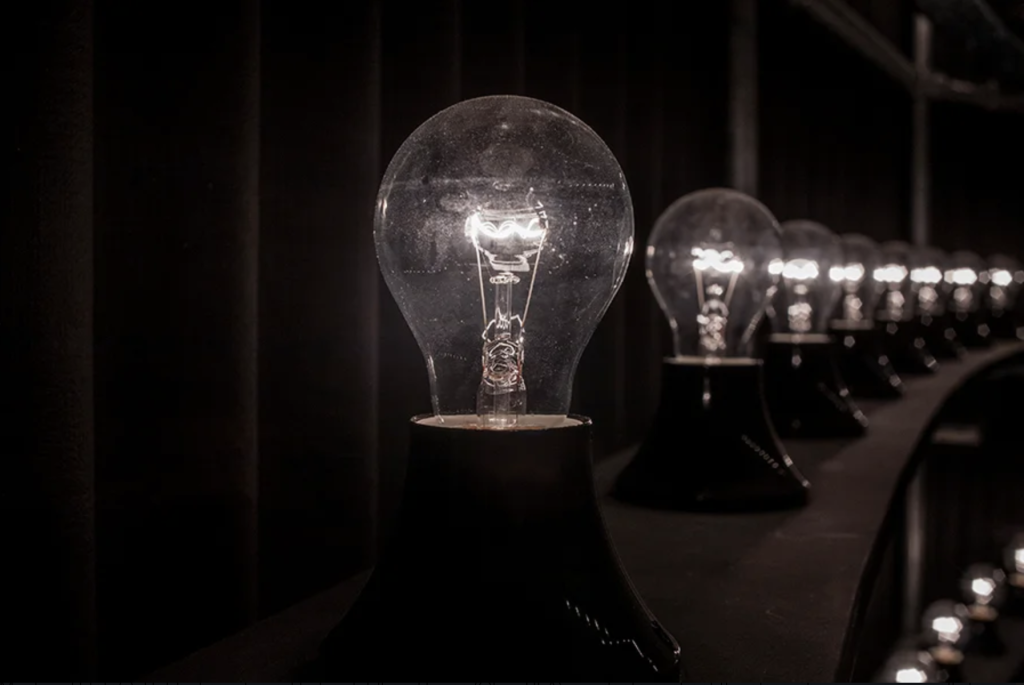INTERROGATING THE NOISE
Dirty Electronics & Dushume
Dates: 28th Feb – 24th March 2023
Venue: Stephen Lawrence Gallery
Part of the:
A cacophony of rhythmic stutters polarising with brutal deep bass – interrogating the noise! Object Noise Clusters made from everyday objects – pots and pans, oil can, oven shelf, coffee pot, clock gongs – are hung from the ceiling and intermittently vigorously shaken by motors. These are placed next to DIY loudspeakers strung-up creating an intense dialogue between acoustic and electronic sound. While rotating speaker horns bounce clicks around the space. Ink drips from a cannula onto a piece of out-stretched vibrating ‘noise’ paper. Watch the artwork unfold as a preview night performance (see panel below).
An in-depth full-page review of this exhibition by Robert Barry, including an account of the Dirty Electronics / Dushume performance, has been published in issue 471 of The Wire (p 88), available through their paywall HERE.

For Want of (not) Measuring
Jim Hobbs & Patrick Adam Jones
Dates: 1 – 23 April 2022
PV: Thursday 31 March 2022 6 – 9pm
Open Thursday – Saturday 12 – 6pm
Venue: Kingsgate Project Space
Whereas measure often focuses on quantitative results, the two artists instead choose a more metaphysical approach to exploit the corporeal use of measuring apparatus. Here, surveying sticks, physical grids and light meters (amongst many other tools) are all used to point out the futility, absurdity and impossibility of truly knowing the world around us. What began as a conversation between the two artists about the overlapping territories of each other’s interests has led to a collaborative installation where the works actively seek out resonance via proximity in space
The first works encountered in the space, 25 fc and 22.5 fc, are two small photographs by Hobbs that document a 1930’s foot candle meter. This apparatus was designed to measure the appropriate luminosity of certain interior conditions for safe working. However, in these photographs, the lighting conditions seem to stay the same while the meter’s needle moves – captured by lowering the lighting conditions whilst increasing the length (time) of exposure. Ultimately these object/images speak of duration, observation and sensitivity.
On the large wall, Patrick Adam Jones has created an immense installation of drawings and framed photographs with ink overlays of text. The mass of images nailed to the wall is entitled How heavy is your mountain and consists of hundreds of drawings, spawning from Jones’ interest in the Schiehallion Experiment. In the 18th century, scientists set out to measure the mean density of the Earth. They worked around the perimeter of Schiehallion mountain in Scotland to try and measure variations based on gravitational pulls from nearby mountains.
The idea that mountains would pull a plumb-line from the vertical was already set out by Isaac Newton (1687) in the third book of his Pincipia where he showed that all three of Kepler’s laws were the consequence of the inverse square law of gravitational attraction. He gave as an example a hemispherical mountain 3 miles high and 6 miles broad which he said would deflect a pendulum somewhat less than 2 arcmin (actually 1/ 18” if the mountain had the same density and the mean density of the Earth). Newton concluded that such deflections by mountains would be too small to measure. However, over the next 100 years advances in astronomical and surveying techniques made possible such measurements in the hands of a careful observer of which Nevil Maskelyne was the quintessential example. (A Commemoration of Maskelyne at Schieallion, R.D. Davies, 1985)
The drawings which make up How heavy is your mountain are part scientific hypothesis and part ironic self-postulation. Working on top of the indexes from old atlases, the work acts as a palimpsest but also a locator and generator. The writing which overlays many of the drawings, often reflects Jones’ own paradoxical line of enquiry – an internal questioning about an outside world while the mark making suggests the necessity of physically figuring things out.
To take the work even further, Jones’ decided to visit and climb Schiehallion to conduct his own futile experiments of measuring and document the journey through the use of vintage stereoscopic cameras. Carrying a large surveying stick up the mountain, Jones became a shamanic figure, linking the past with the present, the absurd with the real, in a desire to measure something. The resulting images have become the base material for the Schiehallion Series – framed photographs, some of which have subtly drawn numbers, marks and measurements across them. These works include references to a type of landscape Romanticism of the 19th century while also maintaining a genuine sense of awareness, beauty and awe. High on the opposite wall is the work Stupid as an artist measuring a mountain, where Jones seems to sum up the entirety of his oeuvre.
Underneath this work is Nyx (mapping the night sky), a 16mm film by Hobbs created over 4 nights on the Greek island Hydra. Manually filming frame-by-frame from dusk to dawn, the night sky’s movement was captured through quasi-grid like structures made of string. The linear elements infer a type of DIY measuring mechanism that is both useful and imperfect but also nods towards the drawing of constellations; mythmaking in the night sky. When presented on a 2×2 video wall, the screens become both another form of grid and a window through which to see.
In the darkened space, Between the Clouds & Between the Daisies are two more of Jones’ photographic works echoing the work in the lighter space but becoming more intimate in dim light. Additionally, two more of Hobbs’ foot candle photographs, 2 fc & 3.5 fc, exist in the periphery at the back of the space, referencing the shift in luminosity.
Centrally located in the space is the video installation entitled . This work stems from Hobbs’ interest in the nocturnal and the use of artificial lighting to create or enhance an augmented form of vision. The recollected experience of being blinded by lights while driving at night is the catalyst for a series of loosely linked moving images and graphics which in turn create a type of hallucinatory experience . The video is projected onto a monumental blackboard surface which has been enhanced with a hand-drawn grid made with engineers’ chalk. The structure/screen relates to Hobbs’ father’s work at General Electric, where automotive lighting was tested out by projecting street scenes onto a gridded wall and then shining head lamps onto it – measuring the technical/numerical/visual range of the light while also destroying the superficially projected image. With this work, this destruction/dismantling of image through projection onto a marked grid creates a physically disorientating experience. The end result is akin to dreaming as described by Louis Ferdinand Celine: ‘Dreams rise in the darkness and catch fire from the mirage of moving light. What happens on the screen isn’t quite real; it leaves open a vague cloudy space for the poor, for dreams and the dead.’ (Journey to the End of the Night, 1932)
Emanating throughout the space is the sound piece Everything that’s important goes on in darkness. For this, Hobbs collected sounds using an electromagnetic microphone to pick up invisible sonic currents from light sources including automotive lamps and handheld torches which were then run through a variety of analogue effects pedals and digital filters. These audio files were then mixed by Jono Crabbe into the final sound piece. The landscape of this composition sits in direct relationship to all of the other works within the exhibition.

30 November – 18 December 2021
An exhibition and accompanying series of events showcasing the Sound/Image Research Group.
Exhibiting Group Members: Dushume (Amit Dinesh Patel); Jim Hobbs; Andrew Knight-Hill; Emma Margetson; Angela McArthur; Ian Thompson; Jonathan Weinel; Richard Whitby.
Using practice as a tool of critical enquiry, the SOUND/IMAGE Research Group investigates the possibilities available to create new aesthetic experiences through a range of sonic and audio-visual media technologies. Based in the Faculty of Law, Arts and Social Sciences at the University of Greenwich, the group has built an international reputation for hosting public events and conferences. These events seek to bring together creative practitioners and leading academics to share insights and reflect upon the latest audio-visual practices.
Navigating the immersive possibilities of sound in space, the Sound/Image ’21 exhibition includes durational installation, It’s all right. I came back (2021) by Jim Hobbs, plus recent sound-works Boo Su 5’10”, Cultaural Fetish 1′ (2021) and PhliKr 9’43 (2020) by Dushume. New and recent works composed for the IKO speaker feature as part of the exhibition installation; these by Emma Margetson, composer-in-residence during the exhibition, Angela McArthur, and other members of the group. Also presented, is video documentation of the virtual reality work for Oculus Quest, Cyberdream (2020) by Jonathan Weinel and Void (2019) by Andrew Knight-Hill. In conjunction with the works on exhibition, a programme of talks and live events (see below) delves further into the work of the group, including ROT, Greenwich a new performance by Siôn Parkinson and Richard Whitby, with Amit Dinesh Patel.
Emma Margetson, will be working with the IKO as composer in residence during the exhibition, with the resulting work being presented on 8th December in ‘Instrumentalising Spaces’. The IKO residency is funded by the Arts Council England grant, Developing your Creative Practice.
Exhibition curated by Catherine Maffioletti and David Waterworth; Design: Kornelija Bruzaite.

MORIBUND STATE(S)
Jim Hobbs
Dates: 1 – 29 August 2020

For Moribund State(s), Hobbs has returned to his childhood home (Ohio, USA) in order to confront the place where one is originally from. With a perspective that is only gained from a distance (in both time and space), he has gathered indigenous materials in order to forge a series of new works which poetically ascribe a familiar yet foreign place. Anamorphic 16mm film projection combined with digital animation, light pieces choreographed with computer coding (housed in stripped down industrial looking structures inspired by antiquated parabolic lighting blueprints from his father’s archive), new school/old school polaroid photographs, and sounds whose manipulation is a deconstruction of time and meaning from a “recorded prayer”. Together, they work on loops but as they have different time spans they endlessly make new pieces/conversations/connections constantly reinventing the work, with chaos and calm arriving at unpredictable times. The work and the implied narrative hint at something: distance, time, relationship to space/place. These interweaving sensorial systems enable unexpected things to happen. There is a poetry here – an ethereal sense of the known, the recognized. The governance of the personal finds contact points with something much larger, something more human, something with which we can all relate.